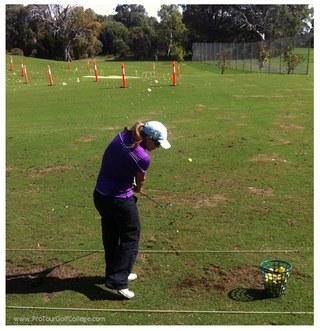 Why do you practice, and what is the purpose behind it? And how do you know if you are practicing correctly? These are great questions you need to ask yourself because they will help you to understand how your current golf practice effort drives your golf performance. If you are like many golfers we’ve asked, you practice because you want to improve some aspect of your golf performance. The purpose for many is to improve golf skills so that you can perform them competently on the golf course. This is logical and the way most golfers think about golf practice. At Pro Tour Golf College we believe that golf practice should do more than develop your golf skills to a higher level of competency. We believe that the process of golf practice should literally transform you into a more effective competitor on the golf course. What this means is that the process of practice should above everything else raise your confidence level to hit your golf shots more proficiently when you perceive increased pressure on the golf course in tournament conditions. But how do you do that? How do you practice so the net effect is better shots when you really need them? In today's article (part 1) we’ll take you through the first 3 habits of the ideal practice process for generating improvement in your game. We will introduce you to simple and easy to learn and do golf practice habits that will transform the way you practice, so that you can perform your golf skills more effectively when it really matters. 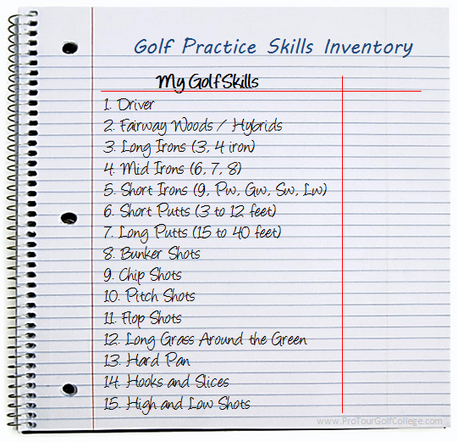 Make a list of all the golf skills that you need to practice Make a list of all the golf skills that you need to practice Golf Practice Habit Number 1 – The Golf Skill Inventory Before you begin to practice your golf skills you need to decide what golf skills you will work on the most. You also need to decide how these chosen golf skills will elevate your performances on the golf course. How many golf skills do you need to practice each week to play more competitively on the golf course? Good question right? Don’t fall into the habit of just practicing the golf skills you are good at, first identify all the golf skills that need to be practiced, and from there classify the key golf skills that need to be developed and improved the most. Start by making a list of all the golf skills that you need to practice on a note pad like the example above. Your list should describe all the long game and short game skills, and also include trouble shots (whether greenside, or off the fairway). These are the golf skills that will help you to produce competitive scores on the course. After all, isn’t the real reason you practice your golf skills to improve your overall performance on the golf course in tournaments? If it’s not, then you need to look a little closer at why you practice the way you do. 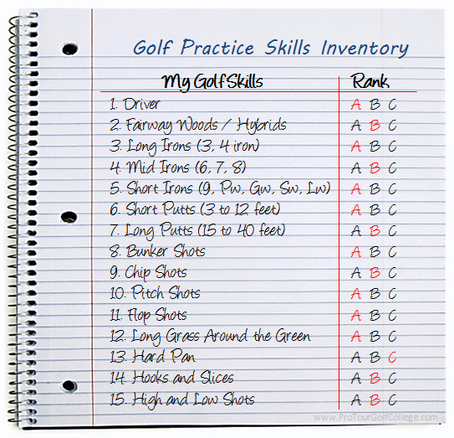 Rank your skills by importance and competency A B or C Rank your skills by importance and competency A B or C Golf Practice Habit Number 2 – The 80/20 Skill Rank The golf score average you are producing currently is the sum total of your level of competency for all the different skills that influence your score. Assess and rank the weakest golf skills out of your list that would have the most positive affect on your performances on the golf course. The simplest way to rank your golf skills is using the A, B and C ranking system, where you rank your skills by level of importance and level of competency. Many different skills make up your game as you can see, but some skills are more influential than others at helping you to score lower. Ranking the golf skills that have the biggest influence on lowering your scores using the simple A, B or C ranking system will help you to stay on top of your skill development. A, B and C Skills Which skills are your ‘A’ skills currently? Your ‘A’ skills are your most important golf skills for lowering your golf score. Your ‘B’ skills are not as important and you are competent at executing them and they come next. This is followed by your ‘C’ skills which are skills you can play competently and rarely play. Now all your skills need to be practiced of course, however over the course of a month your ‘A’ skills which are the 20 percent of golf skills that would make up 80 percent of your score get the most attention. Once you have identified your current ‘A’ skills, you will need to determine what level of competency you are currently at with them. Your level of competency basically describes how capable you are at producing a particular type of shot when you have to in tournaments. Using a simple scale like the one above you can determine your current level of capability -- in this case its tee-shot capability over 6 rounds in tournaments (40 percent success at hitting the fairway) to rate your level of competency. If you rank a flop shot as an ‘A’ skill and you were confronted with a 20 metre flop shot from a tight lie, with a carry of 70 percent to a tight pin position just 2 metres on the green, and a hard and fast green surface, how would you do? Would you be able to play that shot better than 50 percent of the time to within 7 feet (2.5 metres) of the pin? Or how about a slightly downhill 25 metre bunker shot with a steep 2 metre wall facing you where you can just see the top of the pin. How competent would you be with a shot like this? Could you get the ball to within 3 metres of the pin better than 50 percent of the time? You are confronted by many different types of shots during a round, so you must make sure that you are working mostly on your current ‘A’ skills that can help you to keep your score in control. Your ‘A’ skills are your priority golf skills, followed by your ‘B’ skills and then your ‘C’ skills. Golf Practice Habit Number 3 – The Practice Unit Once you have identified your ‘A’ skills and your ‘B’ and possibly your ‘C’ skills you will need to draw up a weekly practice calendar (see below) to manage your golf skill development. You start by determining how many hours you can devote to practicing your golf skills in a week. 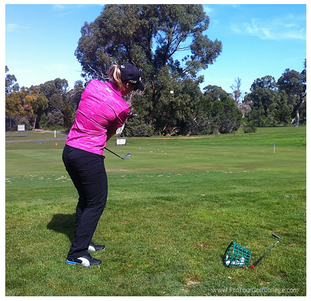 Work on your A1 skills first, then A2 and A3 skills Work on your A1 skills first, then A2 and A3 skills Let’s for example say that you can devote 40 hours per week to practicing your golf skills (including play on the golf course), if you spend 20 hours on the golf course, you have 20 hours left for skill development--your ‘A’ skills will take up around 14 hours or 80 percent of your development time, and your ‘B’ and ‘C’ skills will take about 6 hours. So how do you work out which ‘A’ skills get more of the 14 hours of skill practice and which get less? Rank your ‘A’ skills as A1, A2 and A3. What this is doing is really drilling down into your golf skills to get to the core ‘A’ skills that need more hours of development. Some of the ‘A’ skills will need more technical practice and some will need more targeting practice. This means that you will need to coordinate time within your calendar to spend time with your golf instructor/coach to work on the changes required to raise you level of competence. The easiest way to manage the time aspect of skills development is to work in 30 minute time blocks or units. Basically you allocate the amount of blocks of time you need for each skill. Using the example in our practice calendar above, about 20 hours of skill practice becomes 40 - 30 minute development units. Chunking some of your practice hours into 30 minute practice units makes it a lot easier to allocate sufficient time to the skills that need the most attention. You can see in our calendar that most of the practice hours are split into 2 30 minute practice units.  Next week we’ll continue with our series on the 7 Essential Golf Practice Habits with habits 4 to 7. We will show you how to design the 30 minute golf practice unit, and how you can get really specific with what and how to practice your golf skills within your allocated practice time each week. So see you next week, and have a great week in golf. Lawrie Montague and David Milne - Pro Tour Golf College Your Success On Tour is Our Business Comments are closed.
|
Archives
June 2019
|
Proudly Supported By
Copyright © 2011 - 2018 Pro Tour Golf College
Website Managed By Golf Performance Media
All Rights Reserved
Website Managed By Golf Performance Media
All Rights Reserved



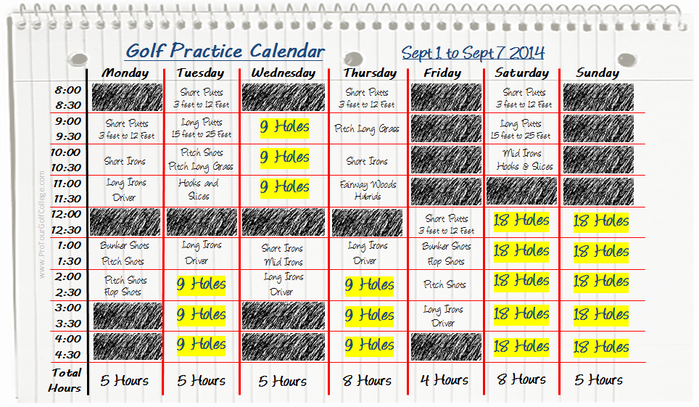
 RSS Feed
RSS Feed



